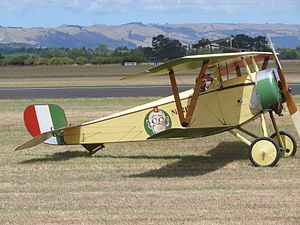Nieuport 11
| Nieuport 11 | |
|---|---|
 |
|
| A replica Nieuport 11 in Italian colours | |
| Role | Fighter |
| Manufacturer | Nieuport |
| Designer | Gustave Delage |
| Introduction | 5 January 1916 |
| Status | retired |
| Primary users |
Aéronautique Militaire (France) Corpo Aeronautico Militare (Italy), Imperial Russian Air Service |
The Nieuport 11, nicknamed the Bébé, was a French World War I single seat sesquiplane fighter aircraft, designed by Gustave Delage. It was the primary aircraft that ended the 'Fokker Scourge' in 1916. The type saw service with several of France's allies, and gave rise to the series of "vee-strut" Nieuport fighters that remained in service (latterly as trainers) into the 1920s.
The Nieuport 11 was a smaller, simplified version of the Nieuport 10, designed specifically as a single-seat fighter. Like the "10" the "11" was a sesquiplane, a biplane with a full-sized top wing with two spars, and a lower wing of much narrower chord and a single spar. Interplane struts in the form of a "Vee" joined the wings together. The sesquiplane layout reduces drag and improves the rate of climb, as well as offering a better view from the cockpit than either biplane or monoplane, while being substantially stronger than contemporary monoplanes. The narrow lower wing may be subject to aeroelastic flutter at high air speeds, a problem that manifested itself on the much faster German Albatros D.III and the later "vee-strut" Nieuport fighters. A single example of the Nieuport 11 was modified with a smaller lower wing and canted interplance struts but no further development ensued. Nieuport 11s were supplied to the French Aéronautique Militaire, the British Royal Naval Air Service, the Imperial Russian Air Service, Belgium, and Italy. 646 Nieuport 11s were produced by the Italian Macchi company under licence, and additional Nieuport 16s were built under licence in Russia by Dux. When Romania suffered military setbacks and needed aircraft, several RNAS Nieuport 11s, along with Nieuport 12s were provided.
In 1916 an improved version appeared as the Nieuport 16 which was a strengthened Nieuport 11 airframe powered by a 110 hp (92 kW) Le Rhône 9J rotary engine. Visible differences included a larger aperture in front of the "horse shoe" cowling and a headrest for the pilot. Later versions had a fuselage-mounted synchronized Vickers gun, but in this configuration the combined effect of the heavier 9J engine and the Vickers gun compromised maneuverability and made the craft nose-heavy. The Nieuport 16 was an interim type pending the delivery of the slightly larger Nieuport 17 C.1 which was designed for the heavier engine and machine gun with a new, full-perimeter ring cowl, and remedied the 16's balance problems, as well as improving performance.
...
Wikipedia
